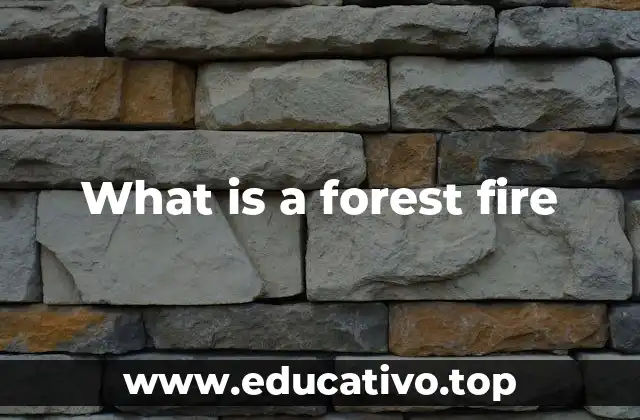A forest fire, also known as a wildfire, is a natural or human-caused event that involves the rapid spread of flames through forested areas. These fires can be devastating, destroying ecosystems, wildlife, and human settlements in their path. Understanding what a forest fire is and how it spreads is crucial for prevention, management, and recovery efforts. In this article, we will explore the causes, effects, and ways to mitigate the damage caused by these destructive events.
¿What is a forest fire?
A forest fire is an uncontrolled fire that spreads rapidly through dense vegetation such as trees, shrubs, and underbrush. These fires often start due to natural causes like lightning strikes or human activities such as campfires, arson, or discarded cigarettes. Once ignited, a forest fire can grow exponentially under favorable conditions such as high temperatures, low humidity, and strong winds. The intensity and speed of the fire depend on the type of vegetation, fuel load, and environmental factors.
Forest fires are not only dangerous to the environment but also pose significant risks to human life and property. In the United States alone, wildfires have burned over 10 million acres annually in recent years. One interesting historical fact is that forest fires have been a part of Earth’s ecosystems for millions of years. In fact, some plant species rely on fire to germinate their seeds, a process known as serotiny. This shows that while forest fires can be destructive, they also play a role in natural cycles of regeneration.
In addition to their ecological impact, forest fires have economic consequences. They can damage infrastructure, disrupt transportation, and lead to costly firefighting efforts. In 2020, the United States spent over $2.3 billion on wildfire suppression efforts. Understanding the nature of these fires is the first step toward managing and reducing their impact.
The role of fire in ecosystems
Fire is a natural and necessary component of many ecosystems. In some environments, periodic fires help maintain biodiversity by clearing out dead vegetation and promoting the growth of new plants. This process is especially evident in ecosystems like the Mediterranean forests, where certain species have evolved to survive and even benefit from fire. However, when fires become too frequent or too intense, they can lead to long-term ecological damage.
For example, in the boreal forests of Canada and Russia, controlled burns are sometimes used as a management tool to reduce fuel load and prevent larger, more destructive fires. These prescribed burns are carefully planned and executed by trained professionals to ensure safety and effectiveness. The use of fire as a management strategy is not new; Indigenous communities around the world have used controlled burning for centuries to manage landscapes and promote biodiversity.
Despite its benefits, the increasing frequency of uncontrolled forest fires due to climate change and human activity is a growing concern. As global temperatures rise, the risk of large-scale wildfires is expected to increase. This makes it even more important to understand how fire functions in ecosystems and how to manage it responsibly.
The environmental impact of forest fires
Forest fires have a profound impact on the environment, both in the short and long term. In the immediate aftermath, they release large amounts of carbon dioxide, contributing to greenhouse gas emissions and global warming. The destruction of plant life also reduces the ability of forests to absorb carbon, further exacerbating climate change. Additionally, the smoke from wildfires can travel thousands of miles, affecting air quality in distant regions.
Wildlife is also severely affected by forest fires. Many animals lose their habitats, and some are unable to escape the flames. Species that rely on specific types of vegetation for food or shelter may struggle to survive in the post-fire environment. However, some animals have adapted to fire-prone ecosystems and have developed survival strategies such as burrowing or fleeing to water sources.
In terms of soil, forest fires can alter its composition and fertility. While some fires enrich the soil with ash, which contains nutrients, intense fires can destroy the topsoil and lead to erosion. This can result in reduced agricultural productivity and increased runoff, leading to flooding in some cases.
Examples of major forest fires
Throughout history, there have been several devastating forest fires that have had lasting impacts on the environment and human communities. One of the most notable is the 1988 Yellowstone fires, which burned nearly 800,000 acres of the national park. The fires were caused by a combination of lightning strikes and dry conditions, and they were exacerbated by a lack of prescribed burning in the area. The blaze lasted several months and became a major environmental and political issue.
Another significant example is the 2019-2020 Australian bushfire season, often referred to as the Black Summer. This fire season burned over 46 million acres, destroyed thousands of homes, and resulted in the deaths of at least 34 people and an estimated one billion animals. The scale of the disaster highlighted the need for improved fire management and climate change mitigation strategies.
Closer to home, the 2020 California wildfires were some of the most destructive in the state’s history. The August Complex Fire alone burned over a million acres, making it the largest wildfire in California’s recorded history. These fires were fueled by dry conditions, strong winds, and a combination of natural and human causes.
These examples illustrate the destructive power of forest fires and the importance of preparedness and response strategies.
The science behind fire behavior
Understanding how forest fires behave is essential for predicting their spread and managing them effectively. Fire behavior is influenced by three main factors: fuel, weather, and topography. Fuel refers to the type and amount of vegetation available to burn. Dry, dense vegetation burns more easily and supports faster fire spread. Weather conditions such as temperature, humidity, and wind speed also play a crucial role. High temperatures and low humidity increase the likelihood of ignition and spread, while strong winds can carry embers over long distances, starting new fires.
Topography affects fire behavior by influencing the direction and speed of the fire. Fires tend to move faster uphill because heat rises, and flames can preheat the vegetation above them, making it more flammable. Conversely, fires tend to slow down when moving downhill. Understanding these factors allows firefighters to anticipate fire behavior and develop effective suppression strategies.
In addition to these three factors, the concept of the fire triangle is often used to explain how fires start and spread. The fire triangle consists of three elements: fuel, oxygen, and heat. If any one of these elements is removed, the fire will go out. This principle is the basis for many fire suppression techniques, such as using water to cool the fire or removing fuel sources through controlled burns.
A list of major forest fires in history
- 1910 Great Fire of the Pacific Northwest – Known as Big Blowup, this fire burned over 3 million acres in Idaho and Montana.
- 1988 Yellowstone Fires – Burned nearly 800,000 acres and sparked national debate on fire management.
- 2009 Black Saturday Bushfires (Australia) – Killed 173 people and destroyed over 2,000 homes.
- 2019-2020 Australian Bushfires – Known as Black Summer, burned over 46 million acres and killed an estimated one billion animals.
- 2020 California Wildfires – The August Complex Fire became the largest in California’s history, burning over 1 million acres.
These events highlight the devastating impact of forest fires and the importance of preparedness, prevention, and effective response strategies.
The human and economic toll of wildfires
Wildfires have a profound impact not only on the environment but also on human lives and economies. When a wildfire strikes, it can displace entire communities, destroy homes, and lead to loss of life. In addition to the immediate dangers, the long-term effects include health issues from smoke inhalation, economic losses from property damage, and the cost of rebuilding and recovery efforts.
The economic burden of wildfires is staggering. In the United States, the cost of wildfire suppression alone has risen dramatically in recent years. In 2020, the National Interagency Fire Center reported that over $2.3 billion was spent on firefighting efforts. Beyond that, the cost of rebuilding homes, repairing infrastructure, and treating health issues related to smoke exposure can run into the tens of billions of dollars.
Communities affected by wildfires often face long-term challenges, including loss of income, mental health issues, and displacement. The impact is especially severe for those who rely on agriculture or tourism, as these industries are often disrupted for years after a major fire event.
What is the purpose of managing forest fires?
Managing forest fires is essential for protecting human life, property, and the environment. The primary goal of fire management is to reduce the risk of large, uncontrolled fires that can cause widespread destruction. This is achieved through a combination of prevention, preparedness, and suppression strategies.
Prevention efforts include public education campaigns, fire restrictions during high-risk periods, and the enforcement of laws against illegal burning. Preparedness involves training firefighters, maintaining equipment, and developing emergency response plans. Suppression strategies include direct firefighting efforts such as using water and fire retardants, as well as indirect methods like creating firebreaks by clearing vegetation.
In addition to these active measures, managed or prescribed burns are used to reduce fuel loads and prevent more severe fires in the future. These controlled burns are carefully planned and executed to ensure safety and effectiveness. By managing fire as part of the ecosystem, communities can reduce the risk of catastrophic wildfires.
Understanding wildfire terminology
To effectively discuss and manage forest fires, it’s important to understand the terminology used in the field. Some key terms include:
- Wildfire: A fire that occurs in wildland areas, often spreading rapidly and consuming large amounts of vegetation.
- Prescribed Burn: A planned fire used to reduce fuel loads and manage ecosystems.
- Firebreak: A strip of land cleared of vegetation to stop or slow the spread of a fire.
- Fireline: The edge of a fire, where the flames are actively burning.
- Backfire: A fire set by firefighters to consume fuel in the path of an advancing wildfire.
- Smokejumpers: Firefighters who parachute into remote areas to combat wildfires.
These terms are essential for understanding the strategies and operations involved in wildfire management. Each term represents a specific role or action in the complex process of controlling and preventing wildfires.
The global scale of forest fires
Forest fires are a global issue that affects countries across every continent except Antarctica. Each year, millions of acres of forest are lost to wildfires, impacting both natural ecosystems and human populations. In regions like the Amazon rainforest, wildfires are often linked to deforestation and land clearing for agriculture, compounding the environmental damage.
In 2020, the World Resources Institute reported that over 10 million hectares of primary forests were lost globally due to fires and land conversion. The Amazon alone experienced a 20% increase in fire incidents compared to the previous year. In Indonesia, fires linked to palm oil plantations have caused severe air pollution and contributed to global carbon emissions.
The global scale of forest fires underscores the need for international cooperation in fire prevention, management, and climate change mitigation. Organizations such as the United Nations and the World Firefighters’ Challenge have initiated programs to share knowledge and resources between countries to address this shared challenge.
The meaning of forest fire
A forest fire is a natural or human-caused phenomenon that involves the uncontrolled burning of vegetation in a forested area. The term encompasses a wide range of fire events, from small, contained blazes to massive wildfires that can span hundreds of thousands of acres. Forest fires can be sparked by a variety of factors, including lightning, volcanic activity, and human actions such as campfires, arson, or equipment malfunctions.
The impact of a forest fire depends on several factors, including the type of vegetation, weather conditions, and the speed at which the fire spreads. Some forest fires burn at low intensity, consuming only surface vegetation, while others can be intense and destructive, burning deep into the soil and killing trees. Understanding the meaning of forest fire is essential for developing effective prevention and response strategies.
In addition to the immediate dangers, forest fires have long-term ecological and economic consequences. They can alter ecosystems, reduce biodiversity, and impact local economies that rely on tourism or agriculture. The study of forest fires involves multiple disciplines, including ecology, meteorology, and environmental science, to better understand their causes and effects.
What is the origin of the term forest fire?
The term forest fire has its roots in the English language and is a direct combination of the words forest, referring to a large area of land covered with trees, and fire, meaning combustion. The concept of forest fires has been known for thousands of years, with early humans recognizing the destructive power of fire and using it as a tool for hunting and land management.
Historically, forest fires were often the result of natural causes such as lightning strikes or volcanic eruptions. However, as human populations grew and land use expanded, the frequency of human-caused fires increased. The term wildfire was later introduced to describe fires that spread rapidly and are difficult to control, distinguishing them from controlled burns used for land management.
The use of the term forest fire in modern environmental science helps categorize and study these events, allowing for better prediction, prevention, and response strategies. Understanding the origin of the term provides insight into how societies have historically viewed and managed fire.
Exploring the phenomenon of wildfires
Wildfires are a complex and dynamic phenomenon that can be influenced by a multitude of factors. Unlike controlled fires, which are carefully managed to achieve specific goals, wildfires are unpredictable and often dangerous. They can be ignited by a variety of sources and can spread rapidly under the right conditions.
One of the key aspects of wildfires is their behavior, which can vary greatly depending on the environment. In some cases, fires may burn slowly and only consume surface vegetation, while in others, they can become intense and consume entire forests. Firefighters use tools such as fire behavior models to predict how a fire will spread and to plan their response accordingly.
Another important aspect of wildfires is their impact on air quality. Smoke from wildfires contains harmful particulates and gases that can travel long distances and affect the health of people living far from the fire. In recent years, wildfires have contributed to some of the worst air quality events in history, with entire cities experiencing hazardous levels of pollution.
How do forest fires affect climate change?
Forest fires have a significant impact on climate change, both as a cause and as a consequence. When forests burn, they release large amounts of carbon dioxide into the atmosphere, contributing to the greenhouse effect and global warming. In fact, wildfires are one of the largest sources of carbon emissions in the world, second only to fossil fuel combustion.
In addition to releasing carbon, forest fires also destroy the trees and vegetation that act as carbon sinks, absorbing carbon dioxide from the atmosphere. This creates a feedback loop in which warmer temperatures increase the likelihood of wildfires, which in turn release more carbon and further contribute to climate change.
Climate change also exacerbates the conditions that lead to forest fires. Rising temperatures, prolonged droughts, and changing weather patterns all contribute to an increase in fire risk. As a result, the relationship between forest fires and climate change is a growing concern for scientists and policymakers around the world.
How to use the term forest fire in context
The term forest fire is commonly used in scientific, environmental, and emergency management contexts. It is often used in news reports, government publications, and academic research to describe the phenomenon of uncontrolled fires in forested areas. Here are some examples of how the term is used:
- News report: A massive forest fire broke out near the town of Redding, forcing over 10,000 residents to evacuate.
- Government publication: The National Park Service is conducting controlled burns to reduce the risk of forest fires during the dry season.
- Academic paper: This study examines the impact of forest fires on biodiversity in the Amazon rainforest.
In addition to these contexts, the term is also used in public education campaigns to raise awareness about fire prevention and safety. Understanding how to use the term correctly is essential for effective communication about this important environmental issue.
The role of climate change in forest fires
Climate change plays a significant role in increasing the frequency and intensity of forest fires. Rising global temperatures lead to drier conditions in many forested regions, making vegetation more susceptible to ignition. Prolonged droughts and heatwaves further exacerbate the risk, creating the perfect conditions for large-scale wildfires.
In addition to temperature increases, climate change also affects precipitation patterns. Some regions are experiencing more intense and frequent rainfall, while others are becoming drier. These changes can lead to an increase in fuel load in some areas and reduce moisture in others, both of which contribute to fire risk.
The impact of climate change on forest fires is not limited to the physical environment. It also affects human behavior, as people may be more likely to engage in outdoor activities that can spark fires during dry periods. As a result, addressing climate change is a crucial part of any comprehensive strategy for managing and reducing the risk of forest fires.
The importance of fire education and awareness
Education and awareness are key components of fire prevention and management. By educating the public about the dangers of uncontrolled fires and the importance of fire safety, communities can reduce the risk of human-caused wildfires. Fire education programs often include information on how to build and maintain firebreaks, how to safely use fire in outdoor settings, and what to do in case of a fire emergency.
In schools, fire safety education is often included in science and environmental studies curricula. These programs teach students about the role of fire in ecosystems, the dangers of wildfires, and the importance of responsible behavior in fire-prone areas. In addition, many communities offer fire safety workshops for adults, especially those living in or near forested areas.
Public awareness campaigns also play a critical role in fire prevention. These campaigns use media, social media, and community outreach to spread important fire safety messages. By increasing public knowledge and engagement, these initiatives help reduce the likelihood of human-caused fires and promote a culture of fire safety.
Vera es una psicóloga que escribe sobre salud mental y relaciones interpersonales. Su objetivo es proporcionar herramientas y perspectivas basadas en la psicología para ayudar a los lectores a navegar los desafíos de la vida.
INDICE









